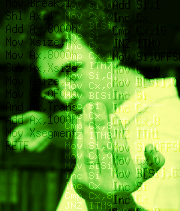
In their game, going without a tutorial phase means that anyone can easily join the game (a 4-player catch-the-flag) without having to be taught the rules first. Because they're doing play-testing at conventions, it also means that people can play together without requiring a "game owner" to explain them how to play.
Ç'aurait pu être la couverture de la "gazette de Bilou 2015" si on était pas en pleine canicule. Je n'ai plus de google reader, mais mes contacts twitter m'apportent de temps en temps une chouette lecture malgré tout. Merci à l'équipe de Juicy Beast qui a pris le temps de quelques articles sur la conception et l'évolution de leur jeu "capture-de-drapeau" au thème sympathique, réalisé dans Unity tant bien que mal et qui rejoint mes propres tentatives de design sur l'organisation des menus.
Ici aussi, les actions du menu sont en réalités commandées par le personnage. Pas de curseur abstrait ou de cases à cocher. Mais les développeurs de Juicy Beast vont un cran plus loin en s'assurant que le joueur aura été confronté aux mécaniques principales de leur jeu avant de se lancer dans l'arène.
 |
| Coming this summer on OUYA, Xbox 360, WiiU, PS4 and Steam. |
PS: I've also read through the more "technical" posts on platforming. They were essentially working around oddities of the collision engine of Unity and detailing how the "raw", analogous input of the directional mushroom are converted into impulses through pre-processing rules such as "if the mushroom gets at rest while we're approaching a cliff, let's step on the breaks and avoid falling". ...
That sheds (yet) another light on those thousands of lines of code just to control the behaviour of Rayman (Origins).
Thanks for sharing, Alex. ^_^



 Vote for your favourite post
Vote for your favourite post



No comments:
Post a Comment